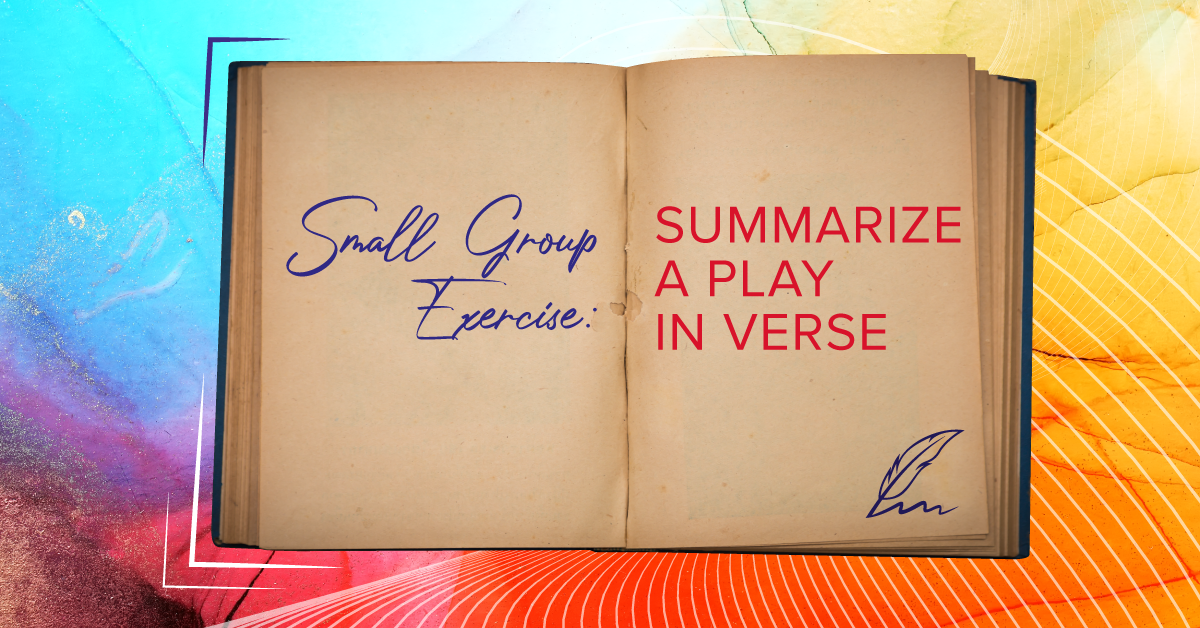Horror Movie 101: Failing Can Be Deadly by Steven Stack is a chilling mix of horror and humor - perfect for student performers and the spooky season! 👻
Small Group Exercise: Summarize a Play in Verse
In this small group exercise, students will write a creative summary of the plot of a play using the ABCB, or “simple 4-line” rhyme scheme. This exercise focuses on creative thinking and teamwork. If you wish to expand this exercise, you can add a performance component, where the group members will perform the piece they created as a dramatic reading.
You may wish to provide your students with a rhyming dictionary and/or a thesaurus to assist them with creating their written pieces. There are also many free online resources available to assist students with finding rhymes and synonyms.
Written Component
The ABCB rhyme scheme is common in English-language verse. The second and fourth lines rhyme, while the first and third do not. For example:
Roses are red, (A)
Violets are blue, (B)
Sugar is sweet, (C)
And so are you. (B)
Let’s say your students are studying Romeo and Juliet. As a class, create a timeline of the major events that occur within the play. For example, Romeo and Juliet meet, they wed in secret, Tybalt is angered and kills Mercutio, Romeo kills Tybalt, Romeo is banished, and so on.
From there, divide the class into groups of two to four. Each group will create their own rhyming summary of the play, using the ABCB rhyme scheme. Each group will decide what important events they wish to include in the piece, and what the overall tone of the piece should be. The piece will have a minimum of four verses (no maximum unless the teacher decides to have one).
Here’s a sample piece:
Romeo loved Rosaline
Or so he claimed to do.
But once he noticed Juliet,
From Rosaline he flew.
This made Tybalt angry,
Revenge is what he sought,
He challenged Romeo to a duel,
And with swords they fought.
Romeo was banished.
Friar Lawrence tried to assist.
Juliet would fake her death
But the message to Romeo was missed.
Romeo drank poison
When he saw his unmoving wife,
When Juliet arose and saw he was dead
She also took her own life.
Each group will submit a written copy of the piece, with all group members’ names on the paper. Additionally, each group member will submit an individual reflection, responding to the following:
- Rate your contribution to today’s group exercise out of 10 (10 being an excellent contributor, 1 being not contributing to the project at all). Why did you give yourself the rating you did? Describe your contributions to the group.
Performance Component
Each group member will perform at least one verse. Give groups some time in class to assign their verses and rehearse. Depending on your preferences, group members can perform “on book” with script in hand, or you may wish to have students memorize their verses at home and perform later in the week, off book. Each group member should use gestures, vocal inflections, and facial expressions to create an engaging performance. Clear enunciation and good volume are always a requirement for a good performance. As well, the overall tone of the piece should be consistent from performer to performer. Even though students are each performing separate verses, they should think of themselves as presenting a single unified piece.



